|
PRODUCE
by John Coté
Photos by Nirmal Govind
At 4 AM. fumes from propane-powered
forklifts cut the soft aroma of green tomatoes and half-ripe bananas.
Dawn is hours away, but the business day is in full swing at Oakland’s
wholesale produce market, four square blocks of open-faced stores with
sweeping awnings just off Jack London Square.
Lumpers – the colloquial term for workers who unload produce –
dart forklifts between a jumble of trucks, crates and each other, building
a maze of Big Jim Oranges and Pim Fresh Cabbage along the sidewalks and
storefronts. Other lumpers wheel dollies stacked with gnarled ginger,
plump eggplant and vibrant chilies through the cold and onto rigs waiting
to deliver them to customers. The fruits and vegetables arrived from farm
shippers as early as 1 a.m. As the sun rises they’ll be trucked as
far away as Napa County to chain grocery stores, independent markets,
restaurants, caterers and other wholesalers.
A similar scene has unfolded in the neighborhood most mornings for the
last 120 years. Now some of the largest produce merchants say economic
pressures will kill the market – about 15 wholesalers who combined
do about $100 million in annual sales – unless the city helps them
move quickly and collectively.
"We’re drowning," said Albert Del Masso, co-owner of Bay
Cities Produce and president of the Oakland Produce Association, a coalition
of wholesalers founded 9 years ago to lobby the city for help. "If
this produce market fails, Oakland won’t have a produce market."
The market is being pressured from several directions as the city looks
to implement Mayor Jerry Brown’s vision to revitalize Oakland. It
lies in the middle of an area slated for redevelopment under the city’s
Estuary Plan. Adopted by the City Council in June 1999, the Estuary Plan
envisions a tourist-friendly area of eclectic retail stores, charming
restaurants and designated open spaces incorporated with residential lofts
and high-tech businesses. The bulk of Oakland’s waterfront property
– a mix of heavy industry, commercial stores, and registered historic
buildings from Adeline St. to 66th Avenue, and the water to the Nimitz
Freeway – is being rezoned for that purpose. The produce market lies
in a key corridor that links downtown Oakland and Chinatown with the bay-front
Jack London Square, promoted in the Estuary Plan as the "East Bay’s
primary dining and entertainment venue."
The Estuary Plan does not call for the removal of the produce market,
but real estate prices in the area have soared, increasing the incentive
for building owners to bring in tenants who pay higher rents. Oakland
Produce Square, a group of 13 businesspeople that owns the four main buildings
in the market, has put them up for sale and refused to renew long-term
leases. Leases that recently expired are now on a month-to-month basis.
Judy Chu, one of the owners, said the time is right to develop the area,
and her group is keeping its options open. She said it would be a smart
business decision for Oakland Produce Square to sell some or all of its
buildings to developers, or else bring in technology companies, preferably
by constructing high-rises.
"The area is due for development," Chu said. "Really anything
is possible."
But putting in high-rises is not part of the Estuary Plan and would seem
a remote possibility, said Betty Marvin of the city’s Community and
Economic Development Agency. It would require petitioning for an exemption
to the zoning laws currently being hammered out by the City Council, since
none of the proposals allow high-rises. Oakland Produce Square’s
buildings, all built between 1916 and 1917, are also on the Local Register
of Historic Resources. Any significant structural changes would require
an environmental impact report, a lengthy and costly study outlining potential
effects on everything from recreation to air quality to geology that would
then be scrutinized by the city, Marvin said.
The historic buildings have also handcuffed the produce merchants, but
for different reasons. The merchants said they simply don’t have
room to put in loading docks, modern refrigeration units or additional
warehouse space. They said their businesses have reached critical mass,
and they’ve had to turn away potential customers like Ralph’s
Groceries and some restaurant chains because they don’t have the
facilities to fill more large orders. The lack of loading docks also makes
the operation less efficient because workers have to do all the unloading
by forklift or by hand.
"I don’t have enough outlets in the office for computer equipment,"
said Gaile Momono, general manager of Fuji Melon, which has a year and
a half left on its lease. "It’s tough to put money into rewiring
a building you don’t own and don’t know how long you’ll
be there."
The antiquated buildings have prompted produce merchants to talk on and
off for 30 years about moving. But the influx of dot-coms, uncertainty
about leases and desire to expand have added a sense of urgency to discussions
with the city about a new site.
"We need to be out of here, and they need to help us get out,"
Del Masso said. "I need to grow and I’ve got people I can’t
supply." Steve Del Masso, Albert’s son and co-owner of Bay Cities,
estimated the market lost $10 million last year because of customers it
had to turn away.
The merchants say all they want is the city to sell them at a fair price
a parcel of land large enough to transplant the whole market intact
.
Don Ratto, who helped found the Oakland Produce Association lobbying group
and co-owns Leo Cotella Produce, the largest merchant in the market, rents
his store from Chu’s group. He has a month-to-month lease, which
allows him 30 days notice if Oakland Produce Square sells and the new
owner wants him out.
"If they throw us out of here, we’re going to relocate,"
Ratto said. "It’ll take a lot of adjusting, but the market has
to stay together."
Most owners agreed the market needs to be a close group of wholesalers
to be successful. Proximity to other produce merchants gives buyers a
broad selection in one place, and allows the wholesalers to simply go
next door to buy parts of a large order they wouldn’t otherwise be
able to fill. If customers have to drive to multiple sites to fill an
order, they will take their business elsewhere, merchants said.
"Collectively you have a viable market," Albert Del Masso said.
"Separately the selling power will be so low we won’t survive."
The Oakland Produce Association has a site in mind, but they say political
foot-dragging has kept them waiting. They want 18 acres between 7th and
Grand streets, on the former Oakland Army Base. The site would provide
them with space to expand, loading docks to increase turnover and a location
where trucks would have easy highway access but wouldn’t disturb
neighbors at 2 a.m. But securing the land requires complicated negotiations
between the produce merchants, the city and the Army.
Wendy Simon, the produce market project manager at the Community and Economic
Development Agency, acknowledged the city’s pace has been slow, but
said the process is complex.
"Everything moves a lot slower than everybody wants, but we are trying
to push the action," Simon said. "It is the city’s intention
to retain these merchants."
The former base is still owned by the Army, but the particular site the
produce merchants want is owned by the Army Reserve, which negotiates
its own contracts. After initial talks with lawyers representing the produce
merchants, Simon said, the Army Reserve decided to deal only with the
city on the transfer, Simon said. This has added another layer to already
complex negotiations, she said—and the merchants’ group is only
one of many competing now for Oakland officials’ attention.
"Personally, I think the market is important," Simon said. "But
I’ve never heard the mayor mention a new produce terminal."
Produce merchants said their less-than-glamorous image has worked against
them in talks with the city, which the merchants contend is more interested
in attracting high-tech companies. "The city is kissing the buns
of the dot-coms," Albert Del Masso said. "All the high-tech
in the world is not going to do you any good if you can’t get fed."
Fuji Melons’ Gaile Momono said the market is often overlooked because
it operates while most people sleep and involves down-to-earth work. But
it does employ 400 unskilled Oakland laborers and pays them good wages,
Momono said. Figures from the city’s Business Tax Division show merchants
last year generated an estimated $100,000 in sales tax revenue for the
city.
A long-time produce merchant who wished to remain anonymous said the market
also provides an opportunity for workers who couldn’t hold 9-to-5
jobs to be successful.
"People are different here," he said. "In society they
are marginal, out of place. But people survive here. Are these people
going to be able to get jobs if this market closes down? Probably not."
The market has long since closed for the day by the time the trendy Soizic
Bistro-Café begins to hum in the afternoon. Half a block down a
black Volvo sedan crushes bruised green tomatoes that had scattered in
the street sometime during the morning mayhem. The driver parks in front
of a law office next to the shuttered store fronts. Without a glance back
the car’s occupants head for Soizic, making Momono’s words seem
eerily prophetic: "Honestly, for most people, they wouldn’t
know it’s gone."
Home
|
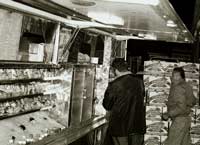
Lumpers
take a coffee break before dawn.
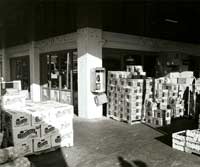
With
space at a premium, all sidewalks are fair game, including those in front
of the neighborhood restaurant, the Oakland Grill.

A
forklift driver pauses before heading back into the unloading fray.
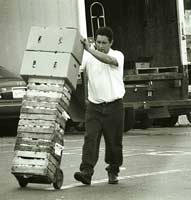
A
lumper runs produce to a waiting truck.
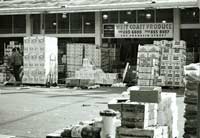
The
modern face of the produce market.
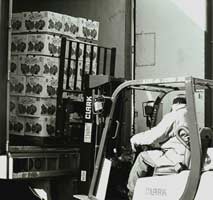
Without
loading docks, forklifts are the backbone fo the produce market.
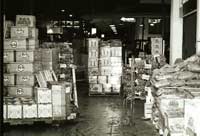
Activity
at the market peaks well before dawn.
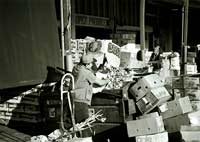
A
worker clears away the remains of a hard morning's work.
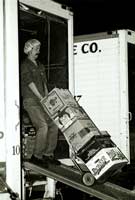
A
lumper at Bay Cities Produce loads a delivery truck by hand.
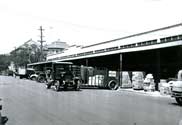
Truck
congestion was not an issue in the 1930s.
(Photo
courtesy of the Oakland Public Library)
|

